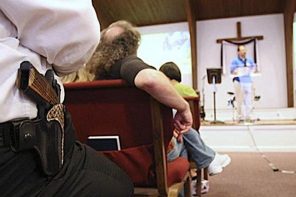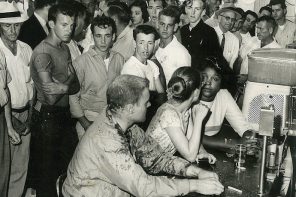It’s a small grace of life that people with winsome projects are easy to spot. As I waited for a train at the LaSalle Street station in Chicago, I met an elderly lady from Washington State who drove to the Midwest only to take pictures of lighthouses. There are many lighthouses in the Great Lakes region, she told me, more than 140 of various shapes and histories. She drove alone and spent more than $800 worth of gas to pursue her unusual passion, staying some nights at various towns along the way. It was enjoyable to hear her speak the way she did.
Then she asked about neighborhoods, and I told her what I knew. Violent deaths are a scourge in Chicago among school-age children, especially on the South Side, where I had once lived in my childhood (Walcott Avenue to be exact). It’s become a statistic to keep track of: the number of school-age children who are murdered, sometimes on school grounds, during a school year, which means the academic year is properly hyphenated. The punctuation gives bone to the unholy facts, but it also creates another set of suburban record-keeping to conjure with. In other words, it makes the reality more abstract, a bit easier to study as citizens.
I teach in Doha, Qatar, throughout most of the year, and I keep up with Chicago news and baseball scores as a matter of routine. I often come across a news item about a felled Chicago public school student, sometimes with an embedded journalistic running count of how many have been lost so far.
Being far away from the city and the country itself alters my reception of the news. Disrobed of important cultural breastplates, I have a hard time receiving the news as “blight as usual.” Most of the victims died from bullets, many of them apparently “stray” bullets meant for someone else. I don’t know if the intended victims have any idea how close they came to their own demise or what little bodies involuntarily saved their lives. As a rule, most of the abstractions are inner-city youth, mainly African Americans, who apparently have the expected duty to die young and unaccomplished, while their mothers weep with an obligatory news camera trained on their surrendered faces.
Mayor Daley has made sure to let us know how upset he is, as have many community leaders, religious figures, and urban activists. Together they have marched the streets shouting for an end to the violence and have held press conferences about the impiety. Rituals follow the violence as a matter of urban sacrament: volunteers staple letter-size paper onto neighborhood trees with the big word “STOP.” Well-wishers drop off stuffed animals and flowers; and they sign, of course, large posters with handwritten prayers, outlines of hearts, and references to the supernal (like “heaven” and “our little angel”), but after the crime tape has been removed and after Chicago firefighters have hosed away the red from the sidewalk.
Stray bullets, children, and official anger: these should be difficult matters to ponder, especially when you wonder what indictment this problem should naturally call up. When violence erupts in the world (especially in developing, non-cross bearing lands) the diagnoses of the self-appointed grand juries of our hemisphere are swift to follow with recommendations to the East that are hardly subtle about closely-held beliefs and scriptures.
But are we permitted to explore what the heartbreak means for Chicago, my hometown, and for America? How do we interpret it: as something that points to a larger problem, or as an unpleasant peccadillo mitigated by our estimations of national greatness? May we suggest a review of the political and cultural temper of our systems (skipping over the typical outrage about video games and single-parent households)? Is the religious leadership open to reviewing church teachings and verses that help inform the national mood on such matters as race? And what about some core ethos, the unmovable parts of cherished secular paradigms, which curiously we broadcast, spend, and bomb to spread to the world? More difficult yet and perhaps more esoteric: how do we begin to comprehend the untraceable loss of some great idea, solution, cure, aesthetic, or some other high meaning, once latent and kept in God-made trust in a youngling, now gone and pulled back by a stray bullet?
Americans live in a violent country. No euphemism can soften the reality for us. Regardless of its outward form, most violence appears to have an internal political bearing, since the killing is often about identity or someone else’s wealth. And if we really think about it, identity is so close to essence, it’s hard to imagine how to detach people, not from identity, but that problem of being lethally adverse toward the other. People, of course, have always shown the capacity to kill for political, cultural, religious, tribal, secular, city-state, or graffiti-marked loyalty. Consider the mortal modern day strife: Jew-Arab (the Holy Land), or Sunni-Shia (Iraq for example), or Protestant-Catholic (Northern Ireland for example), or competing secular economic paradigms like communist-capitalist (Vietnam, Korea, for examples), or tribal Hutu-Tutsi (Rwanda), or underground oil-no oil (Iraq), or views on human ownership and cheap labor (North and South), or urban struggle for abandoned storefronts. Et cetera.
When people kill to gain some material boon, for example, what do we make of it? If we don’t conclude enough then it’s probably because, in part, we all feed from the materialist canon that places an unnaturally high premium on what we have, own, and can throw away as an act of status-making. Don’t we all sing in the choir that inspires a lustful demand for the stuff of comfort and prestige, some lust going over some edge that invites violence to gain the boon? Most of us do not commit crimes to get the coveted appliances, but enough do so to make a comment about the hymn. Poverty is all over the world, but the reaction to poverty clearly differs.
It’s not unusual to observe mysteries associated with something as prevalent as violence. It’s also not unusual to attach metaphors to the reality. It is hard to imagine human life without metaphors. But the metaphors we use to tell others and ourselves about violence (urban or otherwise) are somewhat like the metaphors we apply to illnesses, like AIDS and cancer, about which the late Susan Sontag has written at considerable length in the casual-seeming manner of hers that leave profundity bombs throughout two books in particular: Illness as Metaphor and AIDS and Its Metaphors. She says in the latter book:
There are famous diseases, as there are famous countries… AIDS did not become so famous just because it afflicts whites too, as some Africans bitterly assert. But it is certainly true that were AIDS only an African disease, however many millions were dying, few outside of Africa would be concerned with it. It would be one of those “natural” events, like famines, which periodically ravage poor, overpopulated countries and about which people in rich countries feel quite helpless. Because it is a world event—that is, because it affects the West—it is regarded as not just a natural disaster. It is filled with historical meaning… Nor has AIDS become so publicized because, as some have suggested, in rich countries the illness first afflicted a group of people who were all men, almost all white, many of them educated, articulate, and knowledgeable about how to lobby and organize for public attention. AIDS occupies such a large part in our awareness because of what it has been taken to represent. It seems the very model of all the catastrophes privileged populations feel await them.
The problem of children slain in urban America is usually considered as an inner-city crisis or, worse, an inner-city expectation. The lexical or metaphoric meme of the phrase “inner-city” itself automatically evokes a sense of sure danger, risk, violence, food stamps, social work, and, comfortably, black. We read or listen to the bad news and with carefully consumed bromides accept the information as a ghettoized “natural” fact of life, not something with a pulse to a larger body that communicates something that should nervously provoke a more general discussion. What happens on Walcott doesn’t stay on Walcott, to borrow from the corrupt Las Vegas quip. It’s true that like most kinds of complexity, the boundaries of this issue are frayed, like the woolly edge of a rain front, some stroke where the rain ends, a border that’s somewhat wet and somewhat dry.
During the summer of that conversation with the lighthouse lady, I’ve needed to commute from the far south of Chicago to the far north in Evanston (a North Shore suburb). When I take the scenic route, I see Lake Michigan to my right and, when coming back home, the calming water and sailboats are to my left. Along the way I notice a lighthouse or two or three that I would not have given any attention to, but since I was reminded of lighthouses, I start to see them. That’s what happens when we’re reminded. We begin to see what was nearby all along—things that we simply missed or passively denied.
As for the new hyphenated school year in Chicagoland, a fresh stat will now draw attention to school children in peril, and we will be reminded that these children have the preposterous requirement to walk to school in the morning on the South Side of America and wonder if they’ll make it back home in the afternoon. Some have already been lost this young year, with new rituals and drawings of winged angels and, of course, anger, some of it earnest. Recently, a Fenger High School student was beaten to death, with the violence caught on camera and made public by a local Fox News affiliate, which pushed the event nationally as “good” film normally does. Rev. Michael Pfleger, pastor of St. Sabina Catholic Church, said it right, in words quoted in the Chicago Tribune, “Instead of planning [the victim’s] graduation, his parents are planning his funeral. We are burying our future.”



